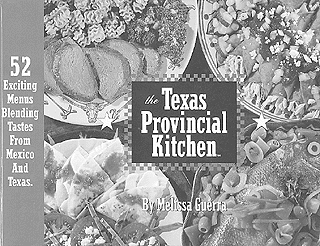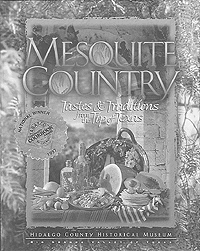Harvesting a Heritage
A Trio of New Texas Cookbooks Preserve Regional Cuisine
By Virginia B. Wood, Fri., Aug. 28, 1998
The Texas Provincial Kitchen
by Melissa Guerra
(self-published, $24.95 paper)

Author Melissa McAllen Guerra is a fifth-generation Texan who lives on a working cattle ranch in far South Texas, not too far from where her family gave land and a name to the city of McAllen. The remoteness of the Santillana Ranch dictated daily cooking, but Guerra began to notice that the culinary heritage with which she'd grown up was slowly being lost to convenience foods and equipment such as microwave ovens. She began compiling recipes and teaching cooking classes to preserve the heritage she valued and soon found herself in possession of enough material for a cookbook. At about the same time, Guerra approached the Rio Grande Valley PBS affiliate KMBH about producing a cooking show based on her book. Armed with a major sponsorship from the HEB grocery chain and support from Valley food producers, Guerra shot the first 26 episodes of Texas Provincial Kitchen on her family's working cattle ranch near the Texas/Mexico border. The shows ran on PBS stations around the state last spring, including KLRU-2, cable channel 20. The new season of Guerra's program is being shot by San Antonio public television station KLRN in the kitchen of the new Broadway Central Market there, but will feature clips of life on the cattle ranch and other points of interest in the border region. They should begin running in the late fall, so keep an eye on local listings.
The recipes in the book are presented in menus with side dishes, breads, and/or dessert because the author felt it was important to provide a sense of context for the foods she loves. Merely presenting recipes "would be like scattering precious gems across a tabletop. Individually, each is enticing and beautiful, but only in the proper setting are their jewels seen in their best light," she writes in the introduction. Guerra's jewels reflect the rich ethnic diversity of the culinary heritage in the Rio Grande Valley. There is a very strong Hispanic influence, to be sure, but the old South is also well represented, and so are the German, Polish, French, and Italian ethnic influences that helped shape the area cuisine. This means that a menu featuring Huachinango a la Veracruzana (Veracruz-style snapper), Chilled Cream of Avocado Soup, Tequila Sugar Cookies, and Agua de Sandia (fresh watermelon water) is followed by another which boasts Chicken Fried Steak with Cream Gravy and Mashed Potatoes, Drop Biscuits with Strawberry Lime Jam, and Chocolate Ice Box Pie. Venison sausages are wrapped in warm flour tortillas, and a menu with pasta and sun-dried tomatoes finishes with coffee flan. The recipes are simply written and easy to follow. Each menu is introduced by a personal anecdote from the author, which creates the impression of being invited into the kitchen of a friend. The overall effect is mouthwatering.
Mesquite Country, Tastes & Traditions From the Tip of Texas
(Hidalgo County Historical Museum, $19.95 hard)
 This is yet another excellent cookbook from the Rio Grande Valley of Texas. The cookbook committee of the Hidalgo County Historical Museum was awarded the top prize at the Tabasco Community Cookbook Awards in 1997, and it's well-deserved. The opening of each chapter contains area history and heirloom photos accompanying treasured recipes from the Valley's best cooks.
This is yet another excellent cookbook from the Rio Grande Valley of Texas. The cookbook committee of the Hidalgo County Historical Museum was awarded the top prize at the Tabasco Community Cookbook Awards in 1997, and it's well-deserved. The opening of each chapter contains area history and heirloom photos accompanying treasured recipes from the Valley's best cooks.
Mesquite Country opens with a chapter on cooking with the native plants of the unique South Texas landscape. There are cakes, cookies, and jelly to be made from the fruits of the ubiquitous mesquite tree, pudding made with chapote or wild persimmon, and several recipes each for cooking with both the pads (nopalitos) and the fruit (tunas) of the nopal cactus. Another chapter offers recipes for the region's plentiful indigenous game, such as venison, wild boar, dove, and quail. The rich Hispanic heritage of the border area is well-represented with aguas frescas (fresh fruit waters) and traditional Mexican sweets like buñuelos (fried flour tortillas dusted with cinnamon-sugar), capirotada (Mexican bread pudding), and pan de polvo (Mexican wedding cookies). I'm eager to try several of the recipes made with the Valley's most prized product, ruby red grapefruit, including salads, pies, and candied grapefruit rind.
The value of community cookbooks is their snapshot of an area's everyday gastronomic history. Mesquite Country creates a vivid portrait of a fascinating Texas region. Proceeds from the sale of the book benefit the museum. If it's not available in local bookstores, Mesquite Country may be ordered from the Hidalgo County Historical Museum, 121 E. McIntyre, Edinburg, Texas 78539; 956/383-6911.
Boardin' in the Thicket: Recipes & Reminiscences of Early Big Thicket Boarding Houses
by Wanda A. Landrey
(University of North Texas Press, $15.95 paper)
Beaumont native Wanda Landrey began her research for this book with an investigation of her own family history and the days when her grandparents and great-grandparents ran the Commercial Hotel in the Big Thicket hamlet of Kountze. From there, she visited sites of the hotels and boarding houses that flourished in the timber-cutting and wildcatting heyday of the early 20th century, gathering family photos, anecdotes, and heirloom recipes along the way.
The Big Thicket area of Texas was once one of the most densely forested areas in the U.S. and was referred to as "the biological crossroads of North America" because of the diversity of plant and animal life there. The original Thicket was generally considered to be an expanse of dense timber stretching about 50 miles north and northwest of Beaumont.
Early settlers found the Thicket a lush, bountiful place in which to live. In its pristine state, it was a very good provider. In it were hardwoods for cabin and furniture building; rich soil for gardens; plentiful game, nuts, and berries; plus creeks, bayous, and rivers filled with fish. By the 1880s, logging companies and railroads brought to the Thicket many new people and new foodways. After the turn of the century, oil was discovered in the area, bringing yet another influx of travelers who had to be housed and fed. Along the rail lines sprang up boarding houses (the author uses the term interchangeably with hotels) ñ comfortable, no-nonsense places where a weary nomad could rest and dine.
Each chapter of the book presents a new hotel with pictures, reminiscences, and recipes. The Springs Hotel Resort at Sour Lake was known for the Squirrel Stew and Squirrel With Dumplings, while the Commercial Hotel treated its patrons to holiday meals which included the Sweet Potato Casserole that Landrey's family still eats at home every year. The chapter on the Vines Hotel in Saratoga offers several pages of recipes that were useful during "hog killin' time," everything from Hog's Head Cheese to Cracking Corn Bread to Pickled Pig's Feet. The Vines Hotel was also the home of Lance Rosier, a Big Thicket native and self-taught naturalist who was a guiding force in the environmental conservation movement that finally set aside a fraction of the area as the Big Thicket Natural Preserve. Most of the lush, verdant Big Thicket is gone now, the victim of progress and timber clear-cutting. The charming old boarding houses went with it. Luckily, Wanda Landrey knew enough to preserve the memories and the foods of the area before they were gone as well.








